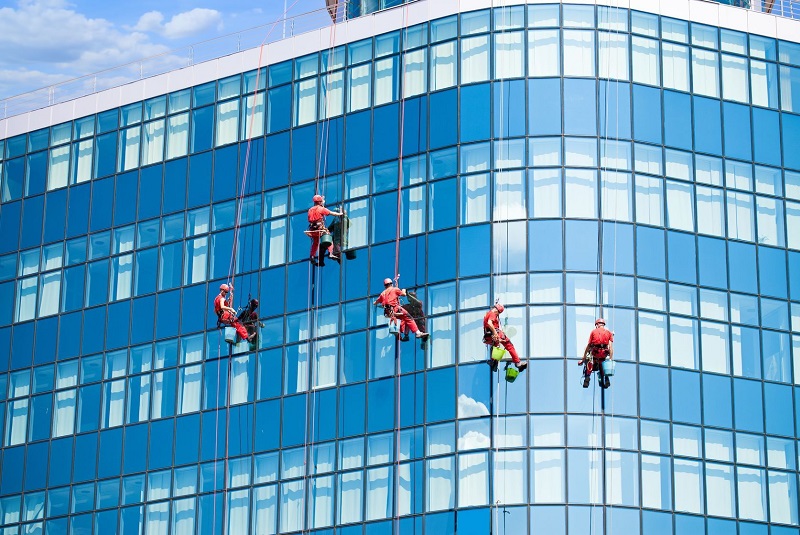High-rise buildings are a staple of modern architecture, contributing to urban skylines and offering breathtaking views. However, maintaining their aesthetic appeal and structural integrity presents unique challenges, especially when it comes to facade cleaning. Traditional cleaning methods can be impractical or hazardous for tall structures. This is where rope access facade cleaning techniques come into play, providing a safe and efficient solution for facade cleaning. This article explores the importance, methods, advantages, and safety considerations of using rope access techniques for high-rise facade cleaning.
The Importance of Facade Cleaning
Aesthetic Appeal
The facade of a high-rise building is often its most visible feature and plays a crucial role in the overall aesthetic of the structure. Over time, dirt, grime, pollutants, and weathering can accumulate on the building’s exterior, dulling its appearance. Regular facade cleaning helps maintain the building’s aesthetic appeal, enhancing the overall perception of the property and its surroundings.
Structural Integrity
Beyond aesthetics, facade cleaning is essential for preserving the structural integrity of high-rise buildings. Accumulated debris can trap moisture against the facade, leading to mold growth, corrosion, and deterioration of building materials. Regular cleaning helps identify and address potential issues early, preventing costly repairs down the line.
Health and Safety
Dirty facades can contribute to poor air quality and health issues for occupants and nearby residents. Pollutants can infiltrate the building’s ventilation systems, exacerbating respiratory problems. Regular facade cleaning ensures a healthier environment for everyone.
Rope Access Techniques: An Overview
What is Rope Access?
Rope access is a specialized method used for accessing hard-to-reach areas, often involving the use of ropes, harnesses, and other safety equipment. Initially developed for industrial applications, rope access has gained popularity in the construction and maintenance sectors, particularly for high-rise buildings.
Methods of Rope Access
Single Rope Technique (SRT): This method involves using a single rope for descent and ascent. It’s commonly used for shorter drops or where access points are limited.
Double Rope Technique (DRT): In this method, two ropes are used: one for ascent and descent, and another for safety. This technique provides an added layer of security, especially for complex or challenging jobs.
Work Positioning Systems: These systems involve specialized equipment that allows workers to maintain a stable position while cleaning the facade. This is particularly useful for extended cleaning tasks.
Advantages of Rope Access for Facade Cleaning
Cost-Effective
Rope access techniques are often more cost-effective than traditional scaffolding or aerial lift methods. The setup time is significantly reduced, and less equipment is needed, leading to lower labor and material costs.
Increased Efficiency
Rope access allows cleaning teams to reach difficult areas quickly and efficiently. Workers can navigate around architectural features, eliminating the need for extensive scaffolding, which can delay projects.
Minimal Disruption
Using rope access techniques minimizes disruption to building occupants and surrounding areas. With no need for heavy machinery or scaffolding, routine activities can continue without interruption.
Enhanced Safety
Rope access technicians are trained to work at heights, using safety harnesses and gear to mitigate risks. The techniques employed in rope access are designed to ensure maximum safety for workers, making it a reliable option for facade cleaning.
Versatility
Rope access can be used for various facade cleaning applications, including pressure washing, window cleaning, and restoration of stonework. This versatility makes it an ideal choice for different types of high-rise structures.
Safety Considerations in Rope Access
Qualified Technicians
Only trained and certified professionals should perform rope access work. Technicians must complete rigorous training programs that cover safety protocols, equipment usage, and emergency procedures.
Equipment Inspection
Before any cleaning operation, all equipment, including ropes, harnesses, and carabiners, should be inspected for wear and tear. Proper maintenance ensures the reliability of safety gear.
Emergency Procedures
Establishing emergency procedures is crucial in case of accidents or equipment failure. All team members should be familiar with these protocols and participate in regular safety drills.
Weather Conditions
Weather can significantly impact the safety and effectiveness of rope access work. High winds, rain, or extreme temperatures can pose risks, so work should be scheduled with these factors in mind.
Site Assessment
A thorough site assessment should be conducted before starting any work. This includes identifying potential hazards, access points, and the specific cleaning requirements for the facade.
Conclusion
Facade cleaning for high-rise structures using rope access techniques is an effective, efficient, and safe solution to maintaining the appearance and integrity of tall buildings. The method offers numerous advantages, including cost savings, minimal disruption, and versatility in application. However, safety should always be a top priority, and only trained professionals should undertake such work. As urban environments continue to evolve and high-rise buildings become more prevalent, the importance of effective facade cleaning methods like rope access will only grow. By investing in regular facade cleaning, property owners can ensure their buildings remain beautiful, structurally sound, and healthy for occupants and the surrounding community.











